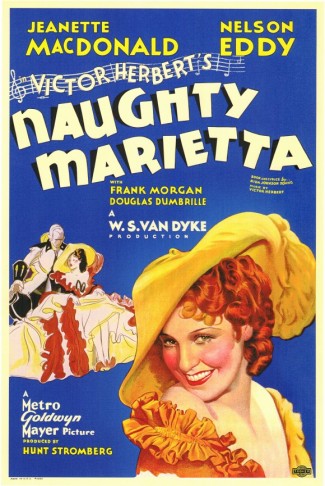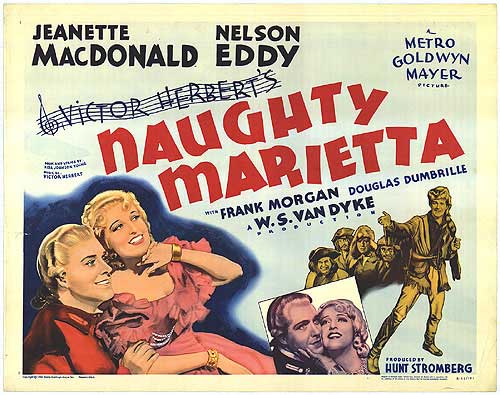Kurt Gänzl
The Encyclopedia of the Musical Theatre
1 January, 2001
Naughty Marietta was written as a commission from impresario Oscar Hammerstein, a transfuge from the world of opera, for a piece to feature the star members of his former opera company: the tiny, sparkling Italian prima donna Emma Trentini, the slightly portly `little Caruso’ of America, Orville Harrold, French contralto Marie Duchêne and the tall, angular bass-baritone Edward Martindel. Mrs Young evolved a period story which cast Trentini as an Italian countess who impersonates a boy, Duchêne as a dramatic quadroon, Martindel as a colonial aristocrat and Harrold as a dashing American adventurer and, since Hammerstein also insisted on the introduction of some comedians from the variety stage to provide what was considered to be the necessary leavening to the operatic elements, she slipped in a couple of funny folk with some irrelevant scenes.

The poster for the hugely popular 1935 movie version of “Naughty Marietta”.
Captain Dick (Harrold), the head of a ranger band of new Americans, has sworn to track down the pirate Bras-Priqué who has been harassing the colonies of the Louisiana coast. No one knows that the marauder is, in fact, the lofty Étienne Grandet (Martindel) whose foolish father has usurped the position of Governor in New Orleans. Marietta, Countess d’Altena (Trentini), who has hidden away on a bride ship to escape an unwanted marriage in Europe, arrives in New Orleans and Dick helps her to hide, disguised as the son of a puppeteer. Marietta has sworn that she will marry only the man who can complete a melody which came to her once in a dream, but Étienne discovers her identity and he determines to wed this profitable, high-born lady, much to the distress of his mistress, Adah (Duchêne), whom he, following the local tradition, puts up for auction at the Quadroon Ball. To Marietta’s jealous annoyance, Dick saves the girl’s face by buying her but Adah repays her benefactor by betraying Étienne’s piratical secret. Dick hurries to find Marietta whom the Grandets have imprisoned, trying to force her into a marriage. Outside her window, he sings to her … it is her dream song and he sings it all the way through. Blades flash, and a happy ending is achieved when Dick’s followers march to the rescue.
Undoubtedly helped and even encouraged by the quality of the voices for which he was writing, Herbert turned out some of his best work in the score of Naughty Marietta. If the comic and choral numbers were unexceptional, Trentini (who complained originally that her songs were too high), Harrold and Duchêne were finely served.
The dream song, `Ah! Sweet Mystery of Life’, had a quality which too many other songs which have been given such a key place in a plot have failed to achieve, and its romantic lyricism happily complemented the vigorous masculinity of Harrold’s `Tramp, Tramp, Tramp’ — destined to become one of the world’s most famous marching songs — his dreamy waltz `I’m Falling in Love with Someone’, and Trentini’s brilliant Italian Street Song and vivacious title-number.
Perhaps the most impressive musical moments, however, came in less obvious places: the quadroon’s sombrely coloured lament `’Neath the Southern Moon’ and the glorious second-act quartet `Live for Today’.
Naughty Marietta underwent very little change on its way to town. Herbert stuck to his guns, and all Trentini’s high notes stayed in, and only one number, an irrelevant attempt at some local colour called `Boo, Mr Voodoo, Don’t You Hoodoo Me’, was dropped. When the show reached Broadway it proved to be a fine success. It played 136 New York performances before moving on to Boston and then to the touring circuits under the management of Hammerstein’s son, Arthur. It returned to Broadway in 1916, then again in 1929 and 1931 with Ilse Marvenga, another Continental star, as Marietta, and was played at San Francisco’s Light Opera in 1941 and in 1948 with film star Susannah Foster featured. In 1955 Patrice Munsel and Alfred Drake starred in a television adaptation.

Another ad for the famous 1935 movie starring Jeanette MacDonald.
However, in spite of its success in America, the show remained relatively unknown overseas until a 1935 film version, starring Nelson Eddy and Jeanette MacDonald (with a slightly different story, which no longer required the lady to get into short pants) popularized Herbert’s songs internationally. `Tramp, Tramp, Tramp’, `I’m Falling in Love with Someone’, `Ah! Sweet Mystery of Life’, `’Neath the Southern Moon’ and the Italian Street Song became perhaps the best known of all Herbert’s music outside America, amateur societies took to the show that held them, and in 1945 British touring manager James Shirvell put out a road company with Lorely Dyer and Derek Oldham starred, directed by Edward Royce, and with a banderole `prior to West End presentation’ attached. It didn’t make it, and New York remains to this day the only theatrical capital to have hosted Naughty Marietta, most recently under the aegis of the New York City Opera (1978).
A further filmed version (ad Neil Simon) was made by NBC-TV in 1955 with Alfred Drake and Patrice Munsel in the leading rôles.
UK: Ladbroke Hall (copyright) 24 October 1910, tour 1945; Film: MGM 1935, NBC-TV
Recording: complete (Smithsonian Institution); selections (RCA Victor, MGM, Columbia, Capitol)
